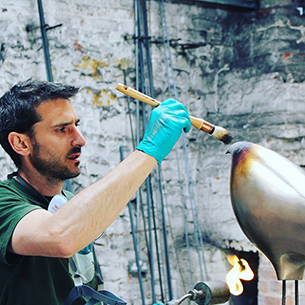Biography
Stephen Page is a British sculptor living and working in rural Mid Wales. He trained at the University of Southampton and specialises in sculpting minimalist animal forms in bronze through the lost wax process.
There is a stillness and solidity to these iconic sculptures which employ subtle curves, rounded forms and sweeping lines to create a gentle movement and grace. The sculptures aim to capture the essence of the creature; excess information is stripped away and the shapes are honed down and simplified creating a pure smooth skin in order to observe the form with the utmost clarity. This simplicity gives the work a timelessness and permanence.
Much of his work is inspired by the art of prehistory and evolve from Stephen’s sketches and drawings before being carved from a dense-foam sculpting material, these patterns are then coated and smoothed back to create the simple and beautiful animal forms that will be replicated in bronze. The castings are heated with a blowtorch and treated with layers of chemicals in order to be sanded back to a fine finish before painting the surface. Some pieces are saturated with a single bold primary colour giving a fresh contemporary feel, while others recreate the translucence of polished marble or granite adding extra weight to the mass of the bronze.
“Simplicity is not an end in art, but we usually arrive at simplicity as we approach the true sense of things.”– Brancusi
Stephen has exhibited extensively throughout the UK in both galleries and art fairs. His works are in collections in the UK, Europe and the USA.
Stephen Page’s sculptures focus on the essence of the creature; excess information is stripped away and the shapes are honed down and simplified creating a pure smooth skin in order to observe form and space with the utmost clarity. This economy of means gives the work a timelessness and permanence, and under their silent outer appearance, they nurture an aspiration to universal form.
There is a stillness and solidity to these iconic sculptures with no dramatic or violent movement. Instead they employ subtle curves, rounded forms and the interaction of different planes and sweeping lines to create a gentle movement and grace. As with the art of prehistory the work takes imaginative liberties with animal form, exaggerating and eliminating features, giving a timeless mythic quality.
“Simplicity is not an end in art, but we usually arrive at simplicity as we approach the true sense of things.”

